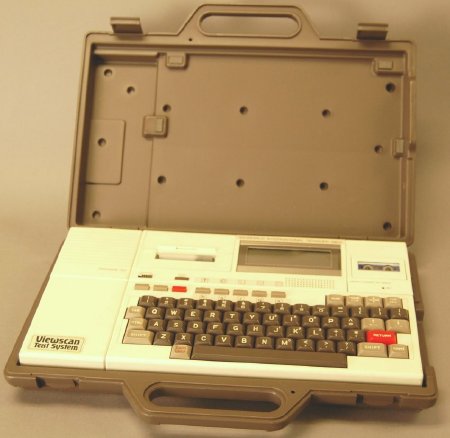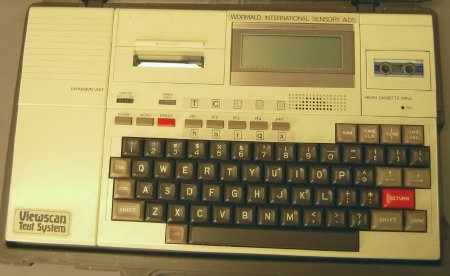Object ID:
2009.24.8
Title:
Viewscan Text System
Creator:
Wormald International Sensory Aids
Description:
(a) Adapted Epson HX-20 computer, cream-toned plastic chassis with expansion unit bracketed on left; QWERTY keyboard, symbol keys in a dark brown, function keys in a gray-brown, return and break keys in red; integral paper tape printer slot in top left, LCD readout screen in top middle (120x32 dots, 20 characters by 4 lines), micro-cassette drive in top right; speaker grill below LCD screen; controls on right side: on/off slider, view angle dial, cassette open, print push button, and jacks for microphone, earphone, remote control, and barcode reader; jacks on back: power adapter, nine-pin RS-232C, and six pin serial; 25-pin jack for camera on left side; label in lower left, "Viewscan Text System"; above LCD screen, "WORMALD INTERNATIONAL SENSORY AIDS"; on silver label on reverse, "EPSON PORTABLE COMPUTER/MODEL HX-20/CODE AA/SERIAL NO. 025143"; on black label on reverse of expansion unit, "VIEWSCAN TEXT SYSTEM/KEYBOARD MODEL VTS 100/SERIAL NUMBER 1034/WORMALD INTERNATIONAL SENSORY AIDS"; (b) dark brown plastic carrying case, fitted for (a), plastic hinge, latches, and handle are integral; cast into latches, "EPSON"; label inset in side "VTS".
Dimensions:
H-1.875 W-14.75 D-8.5 inches
Date:
ca. 1983
Made by:
Wormald International Sensory Aids
Place of Origin:
Japan, New Zealand
Provenance:
Found in AER Migel Library at AFB HQ in New York. The Viewscan, introduced in 1980, was a portable large-print hand-scanning device for people with low vision, and the Viewscan Text System, introduced in 1983, was the first large-print word processor. The VTS-100 was a combination electronic large print display and portable computer, a modified Epson HX-20, with a standard size 80-character LCD display and small built-in printer. With the optional scanning camera, View Scan could magnify the page of a library book up to 40 times onto its small screen. VTS was invented by Russell Smith, a former graduate student of Leslie Kay in New Zealand, while an employee for the Sensory Aids Division of Wormald International. In 1986, Smith spearheaded the development of the first portable talking word processor that was useful to people who were blind or had low vision. The Keynote portable computer was also based on the Epson HX20 computer.
Credit Line:
AFB Migel Memorial Library Collection, 2009.24

